Wednesday, March 25. 2009
Via BLDBLOG and Storefront for Art and Architecture
-----
Postopolis! LA has been gathering pace over the past few weeks, despite the silence, so it seemed like high time for an update. Although we're still finalizing both the schedule and the list of speakers, it's looking amazing so far.
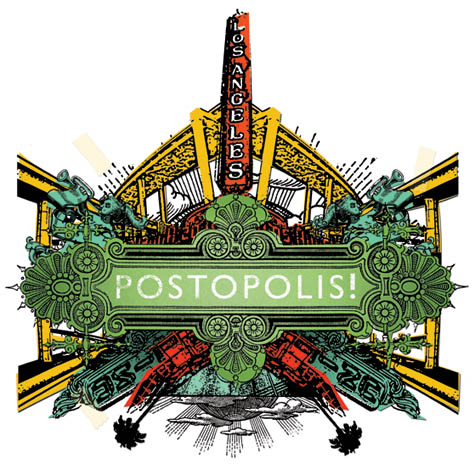 [Image: Logo by Joe Alterio]. [Image: Logo by Joe Alterio].
The whole thing kicks off in less than two weeks, running from Tuesday, March 31, to Saturday, April 4, and from 5pm-11pm everyday.
The venue has finally been announced, as well: we'll be up in the sky, watching the sun set every evening from the rooftop pool, deck, and bar of the Standard Hotel in downtown Los Angeles. The event is free and open to everyone, with a cash bar and free wifi, so come on down for some landscape and architecture, bring your favorite wireless device, and wear your Speedo or bikini if you want to use the pool (it's more like a wading pool, FYI). And, of course, we'll be keeping our fingers crossed for no rain.
The list of speakers, as it now stands, includes unbelievably interesting people. Here's a glimpse:
—Ari Kletzky (Founder, Islands of LA)
—Austin Kelly (Principal, XTEN Architecture)
—Ava Bromberg (Artist, In the Field)
—Ben Cerveny (Strategic and Conceptual Advisor, Stamen Design)
—Benjamin Ball and Gaston Nogues (Architects and Founding Partners, Ball-Nogues Studio)
—Benjamin Bratton (Architect and Theorist)
—Bryan Boyer (Organizer, Helsinki Design Lab 2010)
—Christina Ulke (Artist, Co-Founder, C-Level, and Editor, Journal of Aesthetics and Protest)
—Christopher Hawthorne (Architecture Critic, Los Angeles Times)
—David Burns, Matias Viegener, and Austin Young (Founders, fallen fruit)
—David Gissen (Theorist and Historian, CCA)
—Dwayne Oyler (Architect and Principal, Oyler Wu Collaborative)
—Eric Rodenbeck (Founder, Stamen Design)
—Freya Bardell and Brian Howe (Principals, Greenmeme)
—Fritz Haeg (Artist and Writer)
—Gary Dauphin (Writer and Critic)
—Jeffrey Inaba (Architect and Principal, Inaba Projects)
—Ken Ehrlich (Artist and Writer)
—Mary-Ann Ray (Architect, Writer, and Principal, Studio Works Architects)
—Matthew Coolidge (Director, Center for Land Use Interpretation)
—Michael Dear (Professor of Geography, USC)
—Michael Downing (Deputy Chief of Counter Terrorism, Los Angeles Police Department)
—Mike the Poet (Poet and Writer)
—Orhan Ayyüce (Architect, Blogger, and Senior Editor, Archinect)
—Patrick Keller (Architect and Principal, Fabric)
—Paul Petrunia (Founder, Archinect)
—Robert Miles Kemp (Designer and Principal, Variate Labs)
—Sam Grawe (Editor-in-Chief, Dwell)
—Sharon Johnston and Mark Lee (Architects and Principals, Johnston MarkLee)
—Stephanie Smith (Founder, Ecoshack)
—Steve Roden (Musician and Artist)
—Ted Kane (Architect and Author, Polar Inertia)
—Whitney Sander (Architect and Principal, Sander Architects)
—Yo-Ichiro Hakomori (Architect and Principal, wHY Architecture)
—Zach Frechette (Editor-in-Chief, GOOD)
That's nowhere near the final list, though, as we've also got a handful of media panels planned for Saturday, April 4; these will include Matt Chaban from the Architect's Newspaper, Dakota Smith from Curbed LA, Greg J. Smith of Serial Consign & Vague Terrain, journalist Alissa Walker, a variety of Archinect school bloggers, and many, many more.
So stay tuned for more updates.
And, don't forget, Postopolis! LA will be hosted by BLDGBLOG, City of Sound, mudd up!, Plataforma Arquitectura/Arch Daily, Subtopia, and we make money not art, under the organization of the Storefront for Art and Architecture and the sponsorship of ForYourArt.
Hope to see you there!
Personal comment:
Names (including fabric | ch) at Postopolis!LA.
Monday, March 23. 2009
A summary of what those of us who are thinking, writing and speaking about networked urbanism seem to be seeing: fourteen essential transformations that, between them, constitute a rough map of the terrain to be discovered.
Not sure, in every case, I’ve got the phrasing just right, and will in any event expand on this shortly. Nevertheless:
1. From latent to explicit;
2. From browse to search;
3. From held to shared;
4. From expiring to persistent;
5. From deferred to real-time;
6. From passive to interactive;
7. From component to resource;
8. From constant to variable;
9. From wayfinding to wayshowing;
10. From object to service;
11. From vehicle to mobility;
12. From community to social network;
13. From ownership to use;
14. From consumer to constituent.
-----
Via Adam Greenfield's Speedbird
Wednesday, March 11. 2009
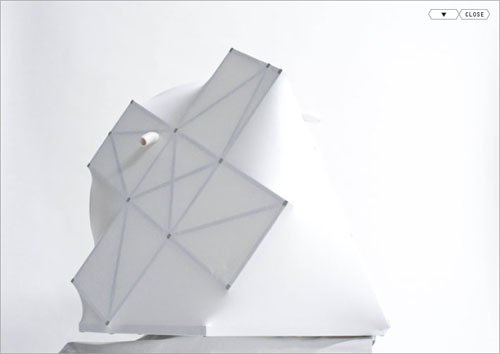
Launching in Seoul at the end of April 2009, the highly anticipated Prada Transformer designed by OMA/Rem Koolhaas will showcase a groundbreaking series of cross-cultural exhibitions, screenings and live events. For five months this shape-shifting venue will host multiple interdisciplinary projects, bringing a unique mix of visual arts to Korea.
The Transformer combines the four sides of a tetrahedron: hexagon, cross, rectangle and circle into one pavilion. The building, entirely covered with a smooth elastic membrane, will be flipped using cranes, completely reconfiguring the visitor's experience with each new programme. Each side plan is precisely designed to organize a different event installation creating a building with four identities. Whenever one shape becomes the ground plan, the other three shapes become the walls and the ceiling defining the space, as well as referencing historic or anticipating future event configurations.
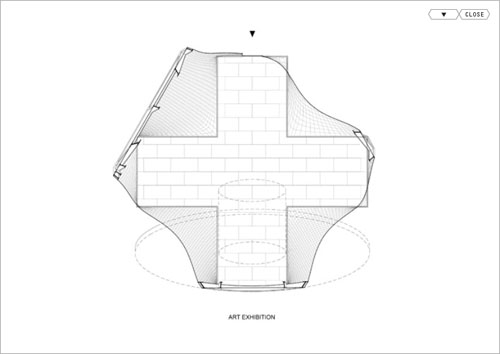
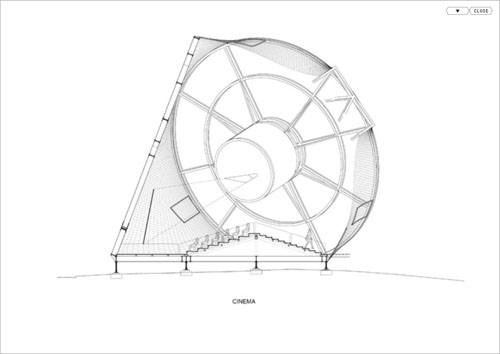
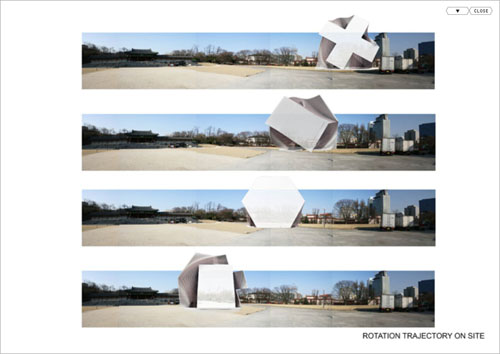
"Waist Down - Skirts by Miuccia Prada", an ongoing project by Miuccia Prada in collaboration with AMO, makes its Korean debut on April 25, showcasing a collection of skirts "in motion" ranging from the first ever Prada show to the present day. Skirts by emerging Korean fashion students will be included to show the interaction between two fashion worlds and to amplify the meaning of fashion from different cultural perspectives.
The exhibition space will then be transformed into a cinema showing a programme of films selected by Alejandro González Iñárritu, the director of Oscar-winning Babel. "Flesh, Mind and Soul" is the concept for the unique programme - to be launched on June 26 - co-curated by film critic Elvis Mitchell, spanning multiple genres, countries and decades of filmmaking including a rich and substantial amount of physical, intellectual and spiritual films that will create a whole cinematic experience.
Subsequently, the Prada Foundation will present an exhibition, "Beyond Control", curated by Germano Celant, which will 'transform' the interior of the architectural object by OMA into an inspiring magma of works by some of the most significant contemporary artists.
Further cultural activities will be announced in the lead-up to the launch of the project. Prada and the Prada Foundation have combined their resources with their local partners' to develop an extraordinary programme for the Prada Transformer's innovative, changing stages. As the fields of fashion, art, film, design and performance now inform and influence each other with increasing diversity and complexity, this programme aims to stimulate and embrace multi-disciplinarian discourse.
Situated next to the 16th-century Gyeonghui Palace, the Prada Transformer - realized with the support of LG Electronics, Hyundai Motor Company and Red Resource Inc. - dramatically juxtaposes Korean history, tradition and folklore with this 21st-century multi-dimensional event space. Due to Seoul Metropolitan Government's passion and dedication to cultural projects, the Prada Transformer was well received and fully supported by the City. Visibly attuned to Seoul's modern positioning as a forward-looking and technologically advanced metropolis, the Prada Transformer is part of Prada's global commitment to the production of new realities in fashion, art, architecture and creative culture.
The architectural project is led by Rem Koolhaas together with associates Kunle Adeyemi and Chris van Duijn, and design architect Alexander Reichert.
As of today, the Prada Transformer is also visible online on pradatransformer.co.kr. The website is the result of a collaboration between Prada, AMO - the mirror image think tank of Rem Koolhaas's Office for Metropolitan Architecture -- and 2x4, a multidisciplinary design studio from NY focusing on art, architecture, and fashion world wide.
The concept of the site is strongly linked to the architectural project. Equal to the built pavilion, which transforms to accommodate different events, the website regenerates its graphics and contents according to the changes in use of the actual structure along time. The main navigation system is a timeline which allows users to intuitively scroll back and forward revealing the calendar of the pavilion and the related content.
-----
Via Archinect
Personal comment:
Evidemment, ce projet me rappelle partiellement les désirs sous-jacents qu'il pourvait y avoir dans notre projet de recherche "Variable_environment" réalisé pour l'ECAL. Même si dans ce cas, nous travaillions à une toute autre échelle... Ce projet de Koolhas sonne un peu comme le retour du refoulé: envie de mobilité, de reconfiguration, etc.
Reste aussi que l'utilisation de ces formes assez basiques et l'aspect finalement assez rude de l'ensemble sonne également comme un statement de ras-le-bol envers les formes "blob" et l'approche algorythmique/générative de la forme pour la forme des ces 10 dernières années.
A noter encore que ce projet lancé par Prada fait écho à celui que Channel a lancé il y a quelques temps déjà (projet par Zaha Hadid à l'instigation de Karl Lagerfeld), mais qui a déjà du être interrompu, soit à cause de son manque de succès (ça ne semble pas être le cas), soit à cause de ses coûts de transports et énergétiques exhorbitants. Il est annoncé sur le site du projet qu'il "n'aurait plus été dans l'air du temps" en 2009...
Monday, March 09. 2009
 [Image: Grapes, 2008, by Ai Weiwei; courtesy of Phillips de Pury & Company]. [Image: Grapes, 2008, by Ai Weiwei; courtesy of Phillips de Pury & Company].
The new exhibition Ai Weiwei: Four Movements opened today in London at Phillips de Pury & Company, and it will remain on display until March 28. I'm proud to have contributed an essay to the show's catalog, alongside a text by Arthur I. Miller.
My essay, "Ai Weiwei: Surgeon of Space" can be read in full online – and I have to admit that I like it! I don't often write about furniture design here on BLDGBLOG, so it was particularly fun to be able to do so.
I suggest that "furniture for Ai Weiwei exists in a very interesting space, so to speak, and it comes with compelling conceptual possibilities."
Furniture doesn’t just ornament a given space; it remakes and redefines the internal boundaries of the space itself. If furniture is something that breaks up space, offering punctuated moments of rest and stoppage and giving rhythm to a room, then it can also be deliberately misused. It can be contrapuntal and off-kilter, designed against the grain of the space it appears within. Furniture can interrupt, challenge, and deform.
The rest of the text veers from David Cronenberg to geology, by way of Gerrit Rietveld and German tunneling machines, Stone Age tools and psychoanalysis. From the essay:
Ai’s "Furniture", subject to such interpretations, become not unlike allegories: small storylines in wood. They are narratives. "Tables at Right Angles", 1998, is really just one table that has misunderstood itself, reeling back from its own projected double. Mistaking its own eccentric solidity for the architecture that surrounds it, this table will never realize that the world it thinks it touches is just another part of itself.
Of course, it would be a cliché to say that these works, thus described, are like poems – so let us instead suggest that they are screenplays: symbolically rich and heavy with implication, they have character, destiny, and tension all at once. They have drama. They can be argued about and reenacted. They have plots. Perhaps someday we might even see a film directed by David Cronenberg – based on a table by Ai Weiwei.
Check it out if you get a chance – and stop by the exhibition itself if you're in London.
Meanwhile, if you're looking for more of an introduction to Ai Weiwei's work, nearly three years ago Archinect published a feature-length interview with him called "Fragments, Voids, Sections and Rings," also well worth a read.
-----
Via BLDBLOG
Personal comment:
Ai Weiwei a collaboré / collabore souvent avec H&M (Herzog & De Meuron), en particulier sur le stade olympique de Pékin.
Friday, March 06. 2009
Archinect and InfraNet Lab are previewing the first issue of [bracket], On Farming. Coming out Winter 2009, it's gonna be awesome. Go see.
-----
Via Pruned
Personal comment:
On avait parlé de cette future revue avec appel à articles derrière laquelle semble être Archinect. Le contenu annoncé des articles semble annoncer une revue aux thématiques assez expérimentales et intéressantes.
|
 [Image: Logo by
[Image: Logo by 



 [Image:
[Image: 